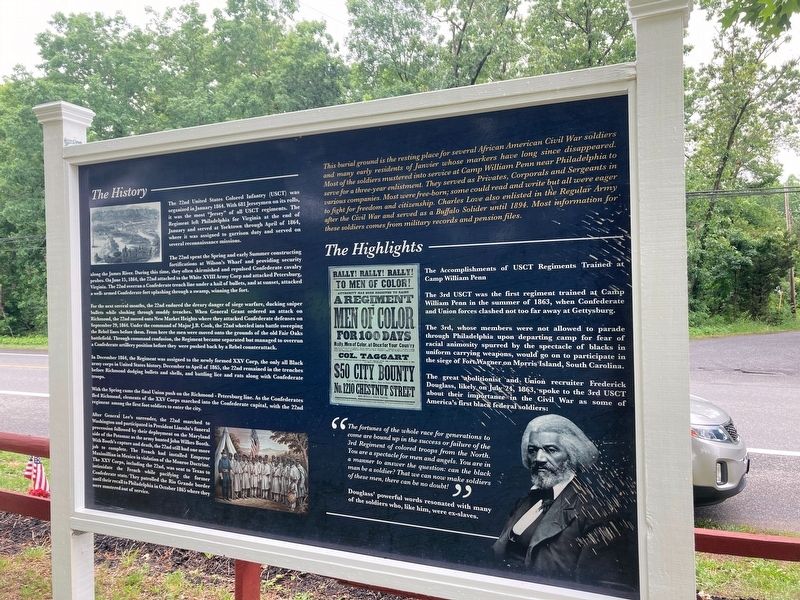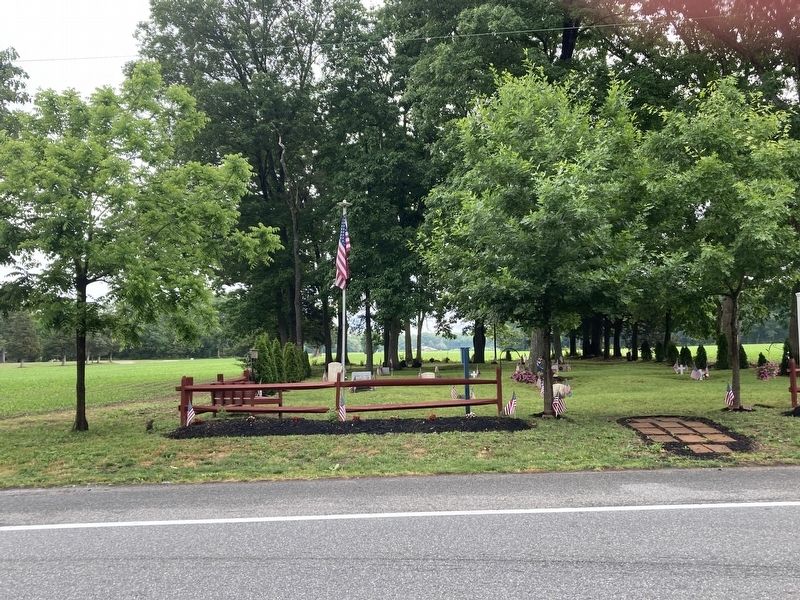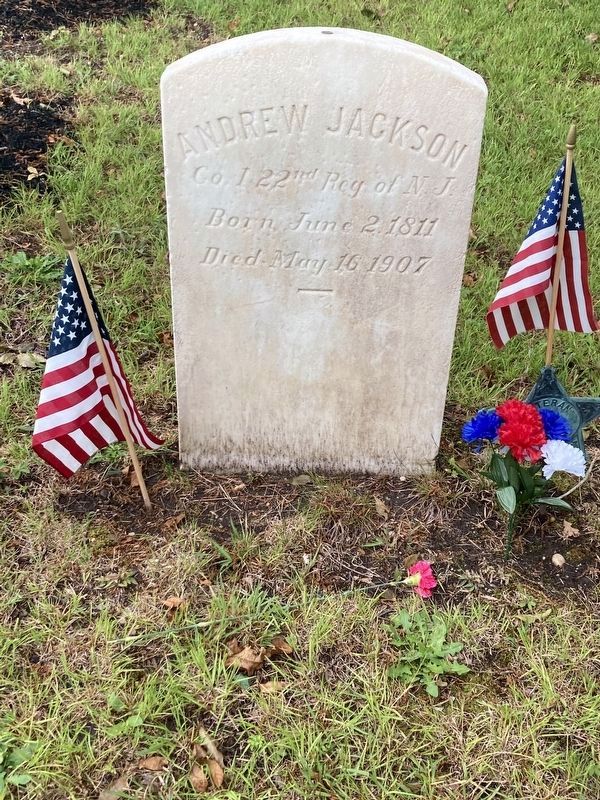Franklinville in Gloucester County, New Jersey — The American Northeast (Mid-Atlantic)
The Buffalo Soldiers - 22nd Regiment U.S. Colored Troops
A Tribute To The United States Colored Troops Who Fought For Our Freedom
— Civil War 1861 to 1865 —
Inscription.
The History
The 22nd United States Colored Infantry (USCT) was organized in January 1864. With 681 Jerseymen on its rolls it was the most “Jersey” of all USCT regiments. The Regiment left Philadelphia for Virginia at the end of January and served at Yorktown through April of 1864, where it was assigned to garrison duty and served on several reconnaissance missions.
The 22nd spent the Spring and early summer constructing fortifications at Wilson’s Wharf and providing security along the James River. During this time, they often skirmished and repulsed Confederate cavalry probes. On June 15, 1864, the 22nd attached to the White XVIII and attacked Petersburg, Virginia. The 22nd overran a Confederate trench line under a hale of bullets, and at sunset, attacked a well-armed Confederate fort splashing through a swamp, winning the fort.
For the next several months, the 22nd endured the dreary danger of siege warfare, ducking sniper bullets while sloshing through muddy trenches. When General Grant ordered an attack on Richmond, the 22nd moved onto New Market Heights where they attacked Confederate defenses on September 29, 1864. Under the command of Major J.B. Cook, the 22nd wheeled into battle sweeping the Rebel forces before them. From here the men were moved onto the grounds of the old Fair Oaks battlefield. Through command confusion, the Regiment became separated but managed to overrun a Confederate artillery position before they were pushed back by a Rebel counterattack.
In December 1864, the Regiment was assigned to the newly formed XXV Corp, the only all Black army corps in United States history. December to April of 1865, the 22nd remained in the trenches before Richmond dodging bullets and shells, and battling lice and rats along with Confederate troops.
After General Lee’s surrender, the 22nd marched to Washington and participated in President Lincoln’s funeral procession followed by their deployment on the Maryland side of the Potomac as the army hunted John Wilkes Booth. With Booth’s capture and death, the 22nd still had one more job to complete. The French had installed Emperor Maximillian in Mexico in violation of the Monroe Doctrine. The XXV Corps, including the 22nd, was sent to Texas to intimidate the French while pacifying the former Confederate state. They patrolled the Rio Grande border until their recall to. Philadelphia in October 1865 where they were mustered out of service.
This burial ground is the resting place for several African American Civil War soldiers and many early residents of Janvier whose markers have long since disappeared. Most of the soldiers mustered into service at Camp William Penn near Philadelphia
to serve for a three-year enlistment. They served as Privates, Corporals and Sergeants in various companies. Most were free-born; some could read and write but all were eager to fight for freedom and citizenship. Charles Love also enlisted in the Regular Army after the Civil War and served as a Buffalo soldier until 1894. Most information for these soldiers comes from military records and pension files.
The Highlights
The Accomplishments of USCT Regiments Trained at Camp William Penn
The 3rd USCT was the first regiment trainee at Camp William Penn in the summer of 1863, when Confederate and Union forces clashed not too far away at Gettysburg.
The 3rd, whose members were not allowed to parade through Philadelphia upon departing camp for fear of racial animosity spurred by the spectacle of blacks in uniform carrying weapons, would go on to participate in the siege of Fort Wagner on Morris Island, South Carolina.
The great abolitionist and Union recruiter Frederick Douglas, likely on July 24, 1863, spoke to the 3rd USCT about their importance in the Civil War as some of America’s first black federal soldiers:
"The fortunes of the whole race for generations to come are bound up in the success or failure of the 3rd Regiment of colored troops from the North. You are a spectacle for men and angels. You are
in a manner to answer the question: can the black man be a soldier? That we can now make soldiers of these men, there can be no doubt!”
Douglass’ powerful words resonated with many of the soldiers who, like him, were ex-slaves.
Topics and series. This historical marker is listed in these topic lists: African Americans • Cemeteries & Burial Sites • War, US Civil. In addition, it is included in the Buffalo Soldiers series list.
Location. 39° 37.619′ N, 75° 0.301′ W. Marker is in Franklinville, New Jersey, in Gloucester County. Marker is at the intersection of Tuckahoe Road (County Route 555) and Sheridan Avenue, on the left when traveling south on Tuckahoe Road. Touch for map. Marker is in this post office area: Franklinville NJ 08322, United States of America. Touch for directions.
Other nearby markers. At least 8 other markers are within 9 miles of this marker, measured as the crow flies. Free Reading Room and Library Association (approx. 3.9 miles away); Christopher Columbus (approx. 4 miles away); First National POW-MIA Memorial Park (approx. 4 miles away); Ireland-Hofer House (approx. 4 miles away); First Police Station (approx. 4 miles away); Friendship Church (approx. 7.8 miles away); Hollybush (approx. 8.1 miles away); Charles Kline Landis (approx. 9.1 miles away).
Credits. This page was last revised on June 8, 2021. It was originally submitted on June 8, 2021, by Thomas Anderson of Haddon Township, New Jersey. This page has been viewed 518 times since then and 109 times this year. Photos: 1, 2, 3, 4. submitted on June 8, 2021, by Thomas Anderson of Haddon Township, New Jersey. • Bernard Fisher was the editor who published this page.



